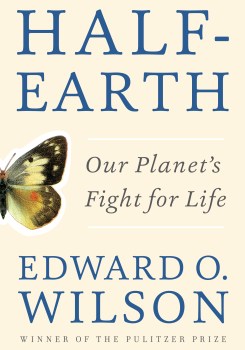Has Human Influence Already Defined a New Epoch?
E.O. Wilson on how we may have already entered the Anthropocene, the Epoch of Man.
The following is an excerpt from Half Earth: Our Planet’s Fight for Life, by Edward O. Wilson.
Sixty-five million years ago, a twelve-kilometer-wide asteroid, traveling at twenty kilometers a second, slammed into the present-day Chicxulub coast of Yucatán. It blew out a hole ten kilometers deep and one hundred eighty kilometers wide, and rang the planet like a bell. There followed volcanic eruptions, earthquakes, acid rains, and a mountainous ocean wave that traveled around the world. Soot shaded the skies, blocking sunlight and photosynthesis. The darkness held on long enough to finish off most of the surviving vegetation. In the killing twilight the temperature plummeted and a volcanic winter gripped the planet. Seventy percent of all species disappeared, including the last of the dinosaurs. On a smaller scale, microbes, fungi, and carrion flies, master scavengers of the living world, prospered for a time on dead vegetation and animal corpses. But soon they, too, declined.
Thus ended the Mesozoic Era, the Age of Reptiles, and began the Cenozoic Era, the Age of Mammals. We are the culminating and potentially final product of the Cenozoic.
Geologists divide the Cenozoic Era into seven epochs, each defined by its combination of distinctive environments and the kinds of plants and animals living in them. First in time was the Paleocene Epoch, an interval of ten million years during which the diversity of life rebounded through evolution from the end-of-Mesozoic catastrophe. Then came in succession the Eocene, Oligocene, Miocene, and Pliocene epochs. The sixth epoch in the progression was the Pleistocene, a time of advancing and retreating continental glaciers.
The final epoch, formally recognized by geologists and the one in which we live, is the Holocene. Begun 11,700 years ago, when the latest of the continental glaciers began to retreat, it brought a milder climate and what may have been briefly the highest peak in numbers of species in the history of life.

The dawn of the Holocene also found humanity newly settled throughout almost all of Earth’s habitable land. All three of the levels in which life is organized faced a new threat with the potential destructive power of the Chicxulub strike. The levels were and remain first the ecosystems, which include coral reefs, rivers, and woodlands; then the species, such as the corals, fishes, and oak trees that make up the living part of the ecosystems; and finally the genes that prescribe the traits of each of the species.
Extinction events are not especially rare in geological time. They have occurred in randomly varying magnitude throughout the history of life. Those that are truly apocalyptic, however, have occurred at only about hundred-million-year intervals. There have been five such peaks of destruction of which we have record, the latest being Chicxulub. Earth required roughly ten million years to recover from each. This is the reason that the peak of destruction that humanity has initiated is often called the Sixth Extinction.
Many authors have suggested that Earth is already different enough to recognize the end of the Holocene and replace it with a new geological epoch. The favored name, coined by the aquatic biologist Eugene F. Stoermer in the early 1980s and popularized by the atmospheric chemist Paul Crutzen in 2000, is the Anthropocene, the Epoch of Man.
The logic for distinguishing the Anthropocene is sound. It can be clarified by the following thought experiment. Suppose that in the far-distant future geologists were to dig through Earth’s crusted deposits to the strata spanning the past thousand years of our time. There they would encounter sharply defined layers of chemically altered soil. They would recognize the physical and chemical signatures of rapid climate changes. They would uncover abundant fossil remains of domesticated plants and animals that had replaced, suddenly and globally, most of Earth’s prehuman fauna and flora. They would excavate fragments of machines, and a veritable museum of deadly weapons.
“The Anthropocene,” far-distant geologists might say, “unfortunately married swift technological progress with the worst of human nature. What a terrible time it was for people, and for the rest of life.”
Adapted from Half Earth: Our Planet’s Fight for Life by Edward O. Wilson. Copyright © 2016 by Edward O. Wilson. With permission of the publisher, Liveright Publishing Corporation. All rights reserved.
Edward O. Wilson is a professor emeritus of biology at Harvard University in Cambridge. He’s the author of multiple books, including A Window on Eternity: A Biologist’s Walk Through Gorongosa National Park (Simon & Schuster, 2014).